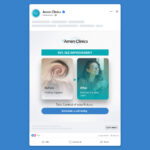The Unseen Influence of Color
In a digital world saturated with content, standing out becomes a game of smart choices and psychological nudges. One such nudge, often underestimated, is the strategic use of color in online marketing. From the high-traffic avenues of social media to the focused corridors of landing pages, color wields a subtle yet significant influence on viewer behavior. But how exactly does this translate into higher conversion rates? Let’s dive into the vibrant world of color strategy in digital marketing.
The Surprising Benefits of Strategic Color Use
Imagine the internet as a bustling city street, and your advertisement as one of the many billboards. In a sea of familiar sights, a flash of contrasting color is like a red car in a stream of white ones – it catches the eye and piques curiosity. This simple analogy encapsulates the essence of using contrasting colors in advertising. When your ad pops, it doesn’t just attract views; it invites engagement.
Contrasting Colors: More Than Meets the Eye
Think about the last time a unique color combination caught your attention. Did it make you pause? Did you feel compelled to explore further? This is the power of contrasting colors in action. By incorporating these into your ad creatives, you’re not just adding aesthetic appeal; you’re creating visual hooks that draw potential customers in. It’s about making your audience stop scrolling and start clicking.
Synchronization: The Key to Seamless Conversions
Now, imagine a potential customer, intrigued by your colorful ad, clicks through to your landing page. They’re greeted with a consistent message and visual theme. This consistency, especially in the call-to-action (CTA) elements, is crucial. It’s about creating a seamless experience from ad to the landing page. The color of your ad’s CTA button matching the landing page’s CTA doesn’t just look good; it feels right. It reassures visitors that they’re on the right path, nudging them closer to conversion.
The Psychology Behind Color Cues
Our brains are wired to follow visual cues. By using color strategically to guide the eyes toward the CTA button or desired action, you’re tapping into instinctual behavior. It’s like laying down a visual trail, leading the viewer exactly where you want them to go – towards conversion.
Controversial Statement: Color is the Unsung Hero of Marketing
In the high-stakes arena of digital marketing, the clever use of color could be as pivotal, if not more so, than the content itself. This statement might ruffle some feathers, especially in a world where content is often hailed as the undisputed king. But let’s pause and ponder this – what good is a king without a crown that catches the eye?
Consider this: every day, your target audience is bombarded with an overwhelming amount of content. In this relentless tide, even the most well-crafted message can get lost if it doesn’t visually stand out. Here’s where color steps in, the unsung hero, working behind the scenes. It’s not just about aesthetics; it’s about visual psychology, about making that split-second connection with the viewer.
Why does this matter? Because in the digital space, attention is the hardest currency to earn. You might have the most compelling content, but without the visual allure to draw the audience in, it’s like a treasure chest hidden in plain sight. The right color choices can amplify your message, create emotional resonance, and set the stage for your content to shine.
Think about some of the most iconic brands and their use of color. There’s a reason why certain brands are instantly recognizable by their color palettes alone. These companies haven’t just chosen their colors for branding; they’ve woven them into the very fabric of their marketing narratives. The colors aren’t just part of the story; they often are the story, setting the emotional tone and anchoring the brand in the minds of consumers.
In the end, saying that color is as important as content in marketing might be controversial, but it’s a debate worth having. It challenges us to think beyond words and images, to consider how colors can turn a good marketing strategy into a great one. In a world where everyone is vying for attention, maybe it’s time to look at color not just as a part of your marketing palette but as a critical tool in your storytelling arsenal. In the art of persuasion, color could very well be your most persuasive brushstroke.
Embracing Color as Your Competitive Edge
In conclusion, the strategic use of color in your digital marketing efforts is not just an artistic choice; it’s a business strategy. As we’ve explored, the right colors can turn your ads and landing pages into visual magnets, compelling viewers to pause, engage, and ultimately, convert. This isn’t about reinventing the wheel but about adding a layer of psychological savvy to your marketing toolkit.
By understanding and applying the principles of contrasting colors, synchronization between ads and landing pages, and the psychology of color cues, you’re not just catching eyes; you’re creating a cohesive, compelling journey for your potential customers. And in a market where attention is the currency, these color strategies could very well be your best investment.
Remember, while trends come and go, the fundamental impact of color on our psyche remains constant. So, the next time you’re planning a campaign, think beyond the content. Consider how the colors you choose can add depth to your message and strength to your call to action. In the end, it’s these subtle touches that can turn browsers into buyers and clicks into conversions. Embrace color, and watch your marketing transform from monochrome to magnificent.






